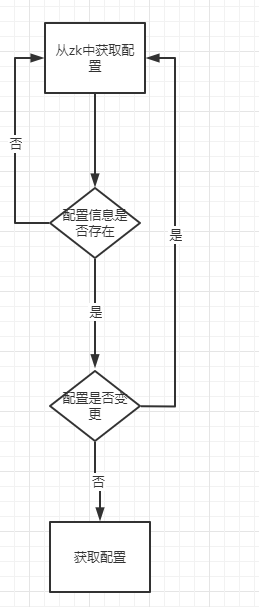作者:Grey
原文地址:ZooKeeper学习笔记三:使用ZooKeeper实现一个简单的配置中心
前置知识
完成ZooKeeper集群搭建以及熟悉ZooKeeperAPI基本使用
需求
很多程序往往是通过心跳检测来判断配置的变更,通过zk的回调机制,我们可以实现比心跳更为快速的配置检测机制,包括配置的新增,修改和删除
流程也比较简单:

环境准备
一个zk集权,ip和端口分别为:
- 192.168.205.145:2181
- 192.168.205.146:2181
- 192.168.205.147:2181
- 192.168.205.148:2181
定义主方法
App.java
public class App {
public static void main(String[] args) {
// 需要监控的路径是/AppConf
String path = "/AppConf";
while (true) {
ConfigCenter configCenter = new ConfigCenter(path);
String conf = configCenter.getConf();
// 配置不为空则拿到最新的配置
if (null != conf && !conf.trim().isEmpty()) {
System.out.println(conf);
}
// 睡眠一段时间
pending(1000);
}
}
}
zk初始化工具类
参考ZooKeeperAPI基本使用中的ZookeeperConfig类,主要的方法为:
public class ZookeeperConfig {
private static final String ADDRESS = "192.168.205.145:2181,192.168.205.146:2181,192.168.205.147:2181,192.168.205.148:2181";
private static ZooKeeper zk;
static CountDownLatch latch;
// 获取一个zk客户端
public static ZooKeeper create() {
latch = new CountDownLatch(1);
try {
zk = new ZooKeeper(ADDRESS, 3000, new DefaultWatch());
latch.await();
} catch (IOException | InterruptedException e) {
e.printStackTrace();
}
return zk;
}
...
}
实现配置中心逻辑
配置中心的入口方法为:getConf()
public String getConf() {
aWait();
return value;
}
其中aWait()方法用于监听配置信息的变动(比如修改,删除,增加),并且通过CountDownLatch阻塞运行,zk一旦监听到配置信息的变动,即会触发回调,并执行countDown(),这样前面的CountDownLatch即可往下运行:
public void aWait() {
zk.exists(conf, this, this, "dasdfa");
try {
latch.await();
} catch (InterruptedException e) {
e.printStackTrace();
}
}
ConfigCenter类实现了Watcher, AsyncCallback.StatCallback, AsyncCallback.DataCallback三个接口,所以监听方法和回调方法都在ConfigCenter中实现,其中,监听方法:
@Override
public void process(WatchedEvent event) {
Event.EventType type = event.getType();
switch (type) {
case None:
break;
case NodeCreated:
System.out.println("node created");
zk.getData(conf, this, this, "node created");
latch.countDown();
break;
case NodeDeleted:
try {
System.out.println("config deleted");
this.value = "";
latch = new CountDownLatch(1);
} catch (Exception e) {
e.printStackTrace();
}
break;
case NodeDataChanged:
System.out.println("node changed");
zk.getData(conf, this, this, "node changed");
latch.countDown();
break;
case NodeChildrenChanged:
break;
case DataWatchRemoved:
break;
case ChildWatchRemoved:
break;
case PersistentWatchRemoved:
break;
}
}
如上,当监听到节点创建和修改的时候,触发getData,当监听到节点删除的时候,重新初始化CountDownLatch,让线程阻塞。
回调方法如下:
@Override
public void processResult(int rc, String path, Object ctx, Stat stat) {
if (stat != null) {
zk.getData(conf, this, this, "getData");
}
}
@Override
public void processResult(int rc, String path, Object ctx, byte[] data, Stat stat) {
if (data != null) {
this.value = new String(data);
latch.countDown();
}
}
方法1表示,当节点存在(stat!=null)的时候,获取一次数据(重新注册监听)。
方法2表示,当节点数据存在的时候,将节点数据取出,并且countDown(),解除阻塞。
运行效果
先把zk中的/AppConf节点删除,执行App.java,程序阻塞
通过zkCli.sh连接任意zk服务端,创建一个/AppConf节点,并赋值
[zk: localhost:2181(CONNECTED) 58] create /AppConf "hello"
Created /AppConf
控制台同时打印出:
node created
hello
hello
hello
hello
hello
hello
hello
hello
继续通过zkCli重新设置/AppConf节点的值
[zk: localhost:2181(CONNECTED) 59] set /AppConf "world"
[zk: localhost:2181(CONNECTED) 60]
配置信息立马生效,控制台打印
...
hello
hello
node changed
world
world
world
...
通过zkCli.sh删除/AppConf节点,控制台阻塞运行,并打印
config deleted
通过zkCli.sh重新创建/AppConf节点,
[zk: localhost:2181(CONNECTED) 61] create /AppConf "hello2"
Created /AppConf
控制台立即解除阻塞,并打印
config deleted
node created
hello2
hello2
..